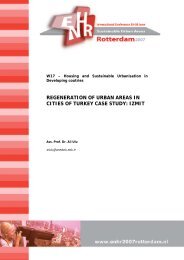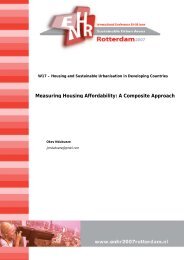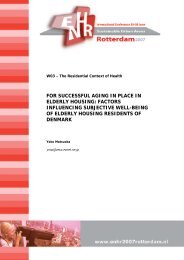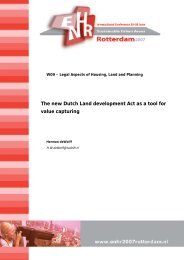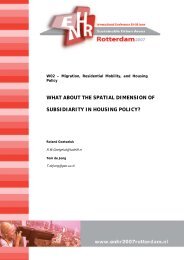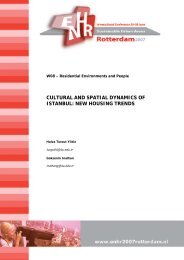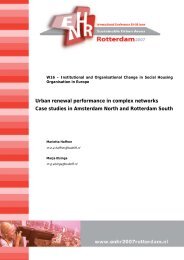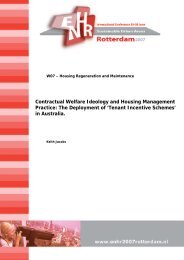urban amenities in a network of cities - ENHR 2007 Rotterdam
urban amenities in a network of cities - ENHR 2007 Rotterdam
urban amenities in a network of cities - ENHR 2007 Rotterdam
Create successful ePaper yourself
Turn your PDF publications into a flip-book with our unique Google optimized e-Paper software.
Urban <strong>amenities</strong> <strong>in</strong> a <strong>network</strong> <strong>of</strong> <strong>cities</strong>: does summ<strong>in</strong>g small <strong>cities</strong> make a large city?2002). This contribution aims to br<strong>in</strong>g the discussion on PURs further by address<strong>in</strong>g thefundamental question <strong>of</strong> whether agglomeration advantages develop at the scale <strong>of</strong> PURs.More specifically, are PURs, despite their polycentric spatial layout, able to reap theadvantages <strong>of</strong> <strong>urban</strong> size <strong>in</strong> a similar way to more monocentric <strong>urban</strong> regions? We elaboratethis question for the provision <strong>of</strong> cultural, leisure and sports <strong>amenities</strong>, contrast<strong>in</strong>g relativelymonocentric regions with comparatively polycentric ones. Put simply, the question is whether<strong>in</strong> three close-by <strong>cities</strong> <strong>of</strong>, say, 100,000 <strong>in</strong>habitants, a similar extent <strong>of</strong> support for such <strong>urban</strong><strong>amenities</strong> can be organised as <strong>in</strong> a city <strong>of</strong> 300,000 <strong>in</strong>habitants. As <strong>in</strong> the economic debate,attention is shift<strong>in</strong>g from the production <strong>of</strong> physical goods to the production and diffusion <strong>of</strong><strong>in</strong>formation, knowledge and <strong>in</strong>novation (Lambooy, 1998b; Van Oort, 2004) the attractiveness<strong>of</strong> <strong>cities</strong> for ‘knowledge workers’ is <strong>in</strong>creas<strong>in</strong>gly important. The presence <strong>of</strong> cultural, leisureand sports <strong>amenities</strong> has consequently become important assets for <strong>cities</strong> (Castells, 1972;Gottlieb, 1995; Zuk<strong>in</strong>, 1998; Brueckner et al., 1999; Glaeser et al., 2001; Florida, 2002). Thepresence <strong>of</strong> these <strong>urban</strong> <strong>amenities</strong> is closely l<strong>in</strong>ked to the size <strong>of</strong> the population <strong>in</strong> a region,permanent or temporary (tourists, bus<strong>in</strong>ess travellers), which makes them a very useful object<strong>of</strong> analysis for our purpose. Does a polycentric spatial lay-out <strong>in</strong>fluence the support base <strong>in</strong>regions for cultural, leisure and sports <strong>amenities</strong>? In order to test for this, we calculated theextent <strong>of</strong> mono- or polycentricity - we consider both extremes <strong>of</strong> the same scale - for 42Dutch regions. We also collected data on the presence <strong>of</strong> cultural, leisure and sports facilities<strong>in</strong> these regions, see section 3. An <strong>in</strong>dex was developed stat<strong>in</strong>g the extent to which these<strong>amenities</strong> are present. The scores on this <strong>in</strong>dex will be l<strong>in</strong>ked to the extent <strong>of</strong>mono/polycentricity as well as some other <strong>in</strong>dependent variables <strong>in</strong> the multiple regressionmodel presented <strong>in</strong> section 4. Does the extent <strong>of</strong> mono/polycentricity expla<strong>in</strong> the presence <strong>of</strong>cultural, leisure and sports <strong>amenities</strong> <strong>in</strong> regions? We will discuss this question <strong>in</strong> the f<strong>in</strong>alsection 5. First, we will theoretically elaborate on the research question <strong>in</strong> the next section.2. Regional externalities <strong>in</strong> PURsMany advanced or rare high-level <strong>urban</strong> <strong>amenities</strong> need a considerable m<strong>in</strong>imum market sizeas regards both demand for the <strong>amenities</strong> <strong>of</strong>fered and the supply for the necessary humancapital. Therefore, a certa<strong>in</strong> critical mass is deemed necessary for <strong>urban</strong> <strong>amenities</strong> to be ableto diversify and function smoothly. As Capello (2000: 1926) argues, ‘the limit that themedium-sized <strong>cities</strong> come up aga<strong>in</strong>st, and which <strong>of</strong>ten makes them succumb vis-à-vis thegreat metropolis, is the limit <strong>of</strong> critical mass and centrality’. Not surpris<strong>in</strong>gly, the highestvalued economic activities and the widest variety <strong>in</strong> economic and cultural functions arefound with<strong>in</strong> the largest agglomerations. It is a strategic issue whether such activities ‘can alsobe realized <strong>in</strong> polynuclear <strong>urban</strong> structures, which lack the critical mass <strong>of</strong> large <strong>cities</strong> withagglomeration economies’ (Lambooy, 1998a, p. 459). If this was possible, it would imply thatexternal economies are equally present <strong>in</strong> PURs as <strong>in</strong> monocentric city regions, though <strong>in</strong> thatcase, given the physical spac<strong>in</strong>g <strong>of</strong> <strong>cities</strong>, they could perhaps be better referred to as ‘regionalexternalities’ (Parr, 2002), or the more broad ‘<strong>urban</strong> <strong>network</strong> externalities’ (Capello, 2000)which possibly apply to <strong>network</strong>s <strong>of</strong> <strong>cities</strong> not necessarily with<strong>in</strong> the same region. Itcorresponds with the concept <strong>of</strong> ‘borrowed size’ as <strong>in</strong>troduced by Alonso (1973). This refersto the situation <strong>in</strong> which close-by and well-connected <strong>cities</strong> host <strong>urban</strong> functions normallyfound only <strong>in</strong> larger <strong>cities</strong>, such as top-level <strong>urban</strong> <strong>amenities</strong>, because the support base islarger given the proximity <strong>of</strong> more <strong>cities</strong>. This view is for <strong>in</strong>stance supported by Burton(1963, p. 287): ‘the functions <strong>of</strong> the miss<strong>in</strong>g regional center have <strong>in</strong> part been taken over bythe next lower group <strong>of</strong> centers’, and Ste<strong>in</strong> (1964, p. 205): ‘the total population <strong>of</strong> a regionalgroup <strong>of</strong> towns and farms will be adequate to utilize and support central facilities equivalentWorkshop: W20- Spatial Plann<strong>in</strong>g and Governance at the Regional LevelAuthor: Evert Meijers4
Urban <strong>amenities</strong> <strong>in</strong> a <strong>network</strong> <strong>of</strong> <strong>cities</strong>: does summ<strong>in</strong>g small <strong>cities</strong> make a large city?detailed travel data is not sufficiently reliable. There exists a relatively objective demarcation<strong>of</strong> city-regions (‘stadsgewesten’), but these depart from a ‘nodal’ perspective and anoverwhelm<strong>in</strong>g majority is consequently monocentric by def<strong>in</strong>ition. Moreover, their scale israther small – supralocal - <strong>in</strong> the light <strong>of</strong> most <strong>of</strong> the <strong>amenities</strong> studied here that function on aregional level. Therefore, we chose a regional delimitation that is relatively recent, that is notby def<strong>in</strong>ition conf<strong>in</strong>ed to old prov<strong>in</strong>cial adm<strong>in</strong>istrative borders such as the Corop-delimitationand that provides for a proxy <strong>of</strong> a functionally coherent region: the WGRsamenwerk<strong>in</strong>gsgebieden.These regions have been delimited with<strong>in</strong> the framework <strong>of</strong> theIntermunicipal Statutory Regulations Act (Wet Gemeenschappelijke Regel<strong>in</strong>gen; WGR). Thisact enables municipalities to jo<strong>in</strong>tly work on issues that need to be addressed on a higherspatial scale than the municipal scale by means <strong>of</strong> issue-based common arrangements. TheAct does not specify which issues should be jo<strong>in</strong>tly addressed, but <strong>in</strong> practice these <strong>of</strong>tenconcern regional aspects <strong>of</strong> economic development, tourism, recreation, hous<strong>in</strong>g,employment, traffic and transport, spatial development, nature and environmental affairs,welfare and social affairs. Until recently, the act required that such common arrangements hadto be clustered with<strong>in</strong> the same regions <strong>in</strong> order to avoid a too territorially uncoord<strong>in</strong>atedpatchwork <strong>of</strong> common arrangements. As the delimitation <strong>of</strong> WGR-regions is based onmunicipal and prov<strong>in</strong>cial adm<strong>in</strong>istrators’ and councillors’ perceptions <strong>of</strong> the scale on whichissues <strong>in</strong> need <strong>of</strong> a regionally coord<strong>in</strong>ated approach rise, these regions provide for an <strong>in</strong>directproxy <strong>of</strong> functionally coherent regions. Despite the ‘pr<strong>of</strong>essional’ def<strong>in</strong>ition <strong>of</strong> this region, theoutcome appears generally well defendable and consequently has not led to strong debate onits rationality. This regional delimitation seems to co<strong>in</strong>cide fairly well with culturallyhomogeneous regions and what are believed to be travel to work areas. Although most arelocated with<strong>in</strong> one Dutch prov<strong>in</strong>ce, some cover the area <strong>of</strong> multiple prov<strong>in</strong>ces. Their averagepopulation size (2005) is 387,034 <strong>in</strong>habitants, the m<strong>in</strong>imum be<strong>in</strong>g 107,620 (Zeeuwsch-Vlaanderen) and the maximum 1,352,680 (Agglomeration Amsterdam). In general, therelatively small size <strong>of</strong> the WGR-regions makes it possible to go from one place to another <strong>in</strong>the same region with<strong>in</strong> half an hour. Here we will refer to them as WGR-regions. Wecollected data for all 42 WGR-regions, which together cover the entire Netherlands (Figure1).Workshop: W20- Spatial Plann<strong>in</strong>g and Governance at the Regional LevelAuthor: Evert Meijers6
Urban <strong>amenities</strong> <strong>in</strong> a <strong>network</strong> <strong>of</strong> <strong>cities</strong>: does summ<strong>in</strong>g small <strong>cities</strong> make a large city?Figure 1. WGR-regions.Source: CBS.1 Oost-Gron<strong>in</strong>gen 15 Rivierenland 29 Rijnmond2 Noord-Gron<strong>in</strong>gen & Eemsmond 16 Eem & Vallei 30 Zuid-Holland-Zuid3 Centraal & Westelijk Gron<strong>in</strong>gen 17 Noordwest-Veluwe 31 Oosterschelderegio4 Friesland Noord 18 Flevoland 32 Walcheren5 Zuidwest-Friesland 19 Utrecht 33 Zeeuwsch-Vlaanderen6 Friesland-Oost 20 Gooi & Vechtstreek 34 West-Brabant7 Noord- & Midden-Drenthe 21 Agglomeratie Amsterdam 35 Midden-Brabant8 Zuidoost-Drenthe 22 Westfriesland 36 Noordoost-Brabant9 Zuidwest-Drenthe 23 Kop van Noord-Holland 37 Zuidoost-Brabant10 IJssel-Vecht 24 Noord-Kennemerland 38 Noord-Limburg11 Stedendriehoek 25 West-Kennemerland 39 Midden-Limburg12 Twente 26 Zuid-Holland-Noord 40 Westelijke Mijnstreek13 Oost-Gelderland 27 Zuid-Holland-Oost 41 Oostelijk Zuid-Limburg14 Arnhem-Nijmegen 28 Haaglanden 42 Maastricht & Mergelland3.2 Cultural, leisure and sports <strong>amenities</strong>We made an <strong>in</strong>ventory <strong>of</strong> the presence <strong>of</strong> certa<strong>in</strong> cultural, leisure and sports <strong>amenities</strong> <strong>in</strong> the42 WGR-regions. The data refers both to quantity and quality. We selected the types <strong>of</strong><strong>amenities</strong> that have a potentially supralocal significance, thus need<strong>in</strong>g the support or criticalmass <strong>of</strong> a region rather than an average-sized city. This excludes both the <strong>amenities</strong>function<strong>in</strong>g at the level <strong>of</strong> small <strong>cities</strong>, as well as most <strong>of</strong> those operat<strong>in</strong>g on a larger, for<strong>in</strong>stance national scale. Data for 20 variables were collected from a wide variety <strong>of</strong> sources.These variables can be grouped <strong>in</strong>to six categories: c<strong>in</strong>ema, theater, museum, concert, sportsand a rest category compris<strong>in</strong>g leisure activities not yet belong<strong>in</strong>g to the other categories.Table I presents details on the variables.Workshop: W20- Spatial Plann<strong>in</strong>g and Governance at the Regional LevelAuthor: Evert Meijers7
Urban <strong>amenities</strong> <strong>in</strong> a <strong>network</strong> <strong>of</strong> <strong>cities</strong>: does summ<strong>in</strong>g small <strong>cities</strong> make a large city?Table I. List <strong>of</strong> variables cultural, leisure and sports <strong>amenities</strong>.Category Variable Year SourceC<strong>in</strong>ema Number <strong>of</strong> screens <strong>in</strong> c<strong>in</strong>emas <strong>in</strong> WGR-region 2005 NVB*Number <strong>of</strong> seats <strong>in</strong> c<strong>in</strong>emas <strong>in</strong> WGR-region 2005 NVBNumber <strong>of</strong> screens <strong>in</strong> art house c<strong>in</strong>emas <strong>in</strong> WGR-region 2005 NVBNumber <strong>of</strong> seats <strong>in</strong> art house c<strong>in</strong>emas <strong>in</strong> WGR-region 2005 NVBNumber <strong>of</strong> screens <strong>in</strong> the largest c<strong>in</strong>ema <strong>in</strong> WGR-region 2005 NVBTheater Number <strong>of</strong> large theaters (>400 seats) <strong>in</strong> WGR-region 2005 TIN**Number <strong>of</strong> medium-sized theaters (200-400 seats) <strong>in</strong> WGRregion2005 TINNumber <strong>of</strong> small theaters (
Urban <strong>amenities</strong> <strong>in</strong> a <strong>network</strong> <strong>of</strong> <strong>cities</strong>: does summ<strong>in</strong>g small <strong>cities</strong> make a large city?Table II. Presence <strong>of</strong> cultural, sports and leisure <strong>amenities</strong> <strong>in</strong> WGR-regions.WGR-region C<strong>in</strong>ema Theater Musea Concert Leisure Sports Total <strong>in</strong>dex1 Oost-Gron<strong>in</strong>gen 88.2 87.0 95.0 90.0 85.6 93.3 89.82 Noord-Gron<strong>in</strong>gen & Eemsmond 79.0 84.5 90.4 90.0 89.5 88.6 87.03 Centraal & West. Gron<strong>in</strong>gen 106.0 93.1 95.0 120.1 115.8 107.4 106.34 Friesland Noord 96.9 92.9 107.8 90.0 85.6 94.1 94.55 Zuidwest-Friesland 89.2 90.4 95.5 92.6 85.6 84.9 89.76 Friesland-Oost 92.6 91.1 89.4 93.3 93.4 108.1 94.67 Noord- & Midden-Drenthe 84.9 85.7 95.0 90.0 85.6 104.8 91.08 Zuidoost-Drenthe 95.9 88.6 86.3 90.0 89.5 94.0 90.79 Zuidwest-Drenthe 89.7 89.4 86.8 90.0 85.6 88.6 88.410 IJssel-Vecht 96.7 103.1 105.2 94.6 116.7 93.8 101.711 Stedendriehoek 105.1 102.0 101.7 94.0 93.4 99.1 99.212 Twente 109.2 124.4 107.3 104.6 112.0 108.1 110.913 Oost-Gelderland 92.1 92.3 96.0 92.4 89.5 90.6 92.214 Arnhem-Nijmegen 132.5 120.8 127.9 118.9 112.0 112.8 120.815 Rivierenland 82.8 91.1 94.0 90.0 85.6 88.6 88.716 Eem & Vallei 107.2 103.1 107.3 91.0 89.5 85.6 97.317 Noordwest-Veluwe 84.6 87.4 89.4 90.0 97.3 88.6 89.618 Flevoland 102.9 93.2 83.7 92.1 85.6 102.7 93.419 Utrecht 109.9 124.0 106.8 113.3 131.4 115.8 116.920 Gooi & Vechtstreek 93.5 94.8 95.6 93.5 89.5 91.9 93.121 Agglomeratie Amsterdam 177.2 174.7 190.1 164.5 139.2 139.2 164.222 Westfriesland 79.0 88.1 97.6 92.8 85.6 88.6 88.623 Kop van Noord-Holland 92.2 89.9 93.5 90.0 85.6 96.2 91.224 Noord-Kennemerland 96.5 96.9 90.9 94.4 93.4 103.8 96.025 West-Kennemerland 98.1 102.7 104.8 105.9 127.5 109.7 108.126 Zuid-Holland-Noord 99.6 87.4 109.5 110.3 89.5 84.9 96.927 Zuid-Holland-Oost 92.3 98.2 90.4 94.4 85.6 84.9 91.028 Haaglanden 129.2 133.8 130.5 113.2 143.1 143.1 132.129 Rijnmond 136.3 127.7 132.5 172.3 127.5 114.2 135.130 Zuid-Holland-Zuid 90.0 101.9 94.5 94.3 89.5 102.5 95.431 Oosterschelderegio 79.0 85.7 89.4 93.4 101.2 88.6 89.532 Walcheren 95.8 84.5 88.9 90.0 85.6 88.6 88.933 Zeeuwsch-Vlaanderen 91.2 93.6 86.8 90.0 101.2 88.6 91.934 West-Brabant 107.1 112.7 101.1 94.6 115.8 118.7 108.335 Midden-Brabant 96.9 98.2 87.8 118.6 85.6 102.3 98.336 Noordoost-Brabant 107.2 116.3 111.9 95.6 97.3 108.8 106.237 Zuidoost-Brabant 115.4 119.3 106.3 108.5 127.5 122.9 116.638 Noord-Limburg 90.9 97.0 88.3 91.8 93.4 91.4 92.139 Midden-Limburg 93.6 89.9 89.4 91.8 89.5 92.3 91.140 Westelijke Mijnstreek 96.0 87.4 81.7 92.1 85.6 93.4 89.441 Oostelijk Zuid-Limburg 91.8 88.2 83.7 90.9 93.4 101.0 91.542 Maastricht & Mergelland 106.2 86.9 94.5 90.0 139.2 94.5 101.93.3 Measur<strong>in</strong>g the extent <strong>of</strong> mono- and polycentricityBasically, polycentricity refers to the plurality <strong>of</strong> centres <strong>in</strong> a given area. As this ‘given area’is undef<strong>in</strong>ed, it may refer to any spatial scale. The term polycentricity as such, is thereforeessentially scale-less. As a consequence, the term has been applied to a wide variety <strong>of</strong> spatialscales rang<strong>in</strong>g from Europe, to many <strong>of</strong> its countries, to regions and to <strong>cities</strong>. However, thereare important differences <strong>in</strong> <strong>in</strong>terpretation between these scales. Davoudi (2003) argues that atlower spatial scales the concept is ma<strong>in</strong>ly analytical, while at the national or European scale itis predom<strong>in</strong>antly a normative concept. However, nowadays, the <strong>in</strong>creased policy attention forpolycentricity has added many normative elements at the local and regional scaleWorkshop: W20- Spatial Plann<strong>in</strong>g and Governance at the Regional LevelAuthor: Evert Meijers9
Urban <strong>amenities</strong> <strong>in</strong> a <strong>network</strong> <strong>of</strong> <strong>cities</strong>: does summ<strong>in</strong>g small <strong>cities</strong> make a large city?(polycentricity be<strong>in</strong>g someth<strong>in</strong>g to strive after), while recently, on the national and Europeanscale attempts have been made to measure polycentricity analytically (Nordregio et al., 2004;IGEAT et al., <strong>2007</strong>; Meijers & Sandberg, 2006). However, also <strong>in</strong> analytical terms there aredifferences. While on the national spatial scale a country's <strong>urban</strong> system is considered morepolycentric when the ma<strong>in</strong> <strong>cities</strong> are evenly distributed across the territory, it is exactly theopposite – a cluster<strong>in</strong>g <strong>of</strong> <strong>cities</strong> – that leads to polycentricity on the regional scale. Here, weadopt Meijers’ theoretical dist<strong>in</strong>ction between polycentric <strong>urban</strong> regions and <strong>urban</strong> <strong>network</strong>s(Meijers, <strong>2007</strong>a). While the first term refers to particular morphological characteristics suchas a cluster<strong>in</strong>g <strong>of</strong> relatively similar-sized <strong>cities</strong> <strong>in</strong> close proximity, <strong>in</strong> fact ‘the image on themap’, the latter term denotes a PUR <strong>in</strong> which relational aspects accord with a <strong>network</strong> logic(see Batten, 1995; Van der Knaap, 2002; Meijers, <strong>2007</strong>b). A regional <strong>urban</strong> <strong>network</strong> istherefore a polycentric <strong>urban</strong> region characterized by functional <strong>in</strong>tegration, by a relativedisconnection between size and function <strong>of</strong> its <strong>cities</strong> as well as by specialisation and<strong>in</strong>teraction, lead<strong>in</strong>g to complementarity. To some extent, this dist<strong>in</strong>ction appears parallel tothe dist<strong>in</strong>ction ‘morphological polycentricity’ and ‘relational or functional polycentricity’(Nordregio et al., 2004), but the latter set <strong>of</strong> terms, particularly ‘relational/functional’polycentricity is less clear on its def<strong>in</strong><strong>in</strong>g characteristics than ‘<strong>urban</strong> <strong>network</strong>’, at least on thisregional scale. Moreover, to avoid confusion, it appears recommendable to reserve the termpolycentricity for morphological issues (see also IGEAT et al., <strong>2007</strong>).Consequently, we should consider the morphological characteristics <strong>of</strong> regions to determ<strong>in</strong>eto what extent they are polycentric. Parr (2004) po<strong>in</strong>ts to the spatial and size distribution <strong>of</strong><strong>cities</strong> <strong>in</strong> the region. In terms <strong>of</strong> spatial distribution, there should be a maximum and am<strong>in</strong>imum limit to centre separation. The spatial distribution <strong>of</strong> <strong>cities</strong> with<strong>in</strong> WGR-regionsdoes not seem to be a very dist<strong>in</strong>guish<strong>in</strong>g factor for measur<strong>in</strong>g polycentricity as it is generallypossible to get from one place to another with<strong>in</strong> the same WGR-region with<strong>in</strong> half an hour. Inaddition, strict Dutch plann<strong>in</strong>g policies have avoided the coalescence <strong>of</strong> separate <strong>cities</strong> <strong>in</strong>tolarger conurbations. Therefore, the size distribution <strong>of</strong> <strong>cities</strong> should be considered the mostimportant <strong>in</strong>dicator for establish<strong>in</strong>g whether or not any region is polycentric or the opposite,monocentric at the regional scale. A dichotomous approach to the question, however, must beavoided. Rather than consider<strong>in</strong>g a given area polycentric or monocentric, it is moreappropriate to score an area on a scale rang<strong>in</strong>g from (very) polycentric to (very) monocentric.The size distribution is even more appropriate for this research as size is strongly related tothe support base <strong>of</strong> regions. Here we will present a measure <strong>of</strong> mono/polycentricity for the<strong>urban</strong> system <strong>of</strong> the WGR-regions based on the rank-size order <strong>of</strong> <strong>cities</strong>. In do<strong>in</strong>g so we partlydraw on the work carried out with<strong>in</strong> the framework <strong>of</strong> the ESPON 1.1.1 project onpolycentricity (Nordregio et al., 2004).Rank-size distribution as <strong>in</strong>dicator for mono-polycentricityCharacteristic for a polycentric <strong>urban</strong> system is that no city dom<strong>in</strong>ates over other <strong>cities</strong> <strong>in</strong>economic, cultural and other respects. In other words, a polycentric <strong>urban</strong> system lacks stronghierarchy. The rank-size distribution <strong>of</strong> the regional <strong>urban</strong> system provides <strong>in</strong>formation onthis hierarchy and is therefore an excellent <strong>in</strong>dication <strong>of</strong> the extent <strong>of</strong> mono- or polycentricity.Figure 2 presents the rank-size distributions <strong>of</strong> three WGR-regions that are either among themost polycentric (Oostelijk Zuid-Limburg), not polycentric nor monocentric (Noord-Kennemerland) or among the most monocentric (Centraal & Westelijk Gron<strong>in</strong>gen). Thepopulation data presented <strong>in</strong> the figure is for the actual towns and villages, not themunicipalities <strong>in</strong> which they are located. In the Netherlands, the average municipalityconta<strong>in</strong>ed just over five and the average WGR-region almost 60 such <strong>cities</strong> and villages <strong>in</strong>2005. The population data was collected for the year 2005. Given the strong stability <strong>of</strong> <strong>urban</strong>systems over time (Batty, 2001), data for one year presents a robust picture.Workshop: W20- Spatial Plann<strong>in</strong>g and Governance at the Regional LevelAuthor: Evert Meijers10
Urban <strong>amenities</strong> <strong>in</strong> a <strong>network</strong> <strong>of</strong> <strong>cities</strong>: does summ<strong>in</strong>g small <strong>cities</strong> make a large city?Figure 2. Monocentric and polycentric rank-size distributions based on five towns perregion.Figure 2 presents the five largest places <strong>in</strong> three regions and also the regression l<strong>in</strong>e that bestfits the distribution <strong>of</strong> their sizes. The argument now is that <strong>in</strong> a polycentric region, with littlehierarchy, this l<strong>in</strong>e will be more flat than <strong>in</strong> a monocentric region. Therefore, the slope <strong>of</strong> theregression l<strong>in</strong>e is a good <strong>in</strong>dicator <strong>of</strong> the extent <strong>of</strong> mono- or polycentricity.Obviously, the number <strong>of</strong> towns <strong>in</strong>cluded <strong>in</strong> the regression analysis <strong>in</strong>fluences the outcome <strong>of</strong>these calculations. In general, sample size can be either a fixed number <strong>of</strong> towns, a fixed sizethreshold, or a size above which the sample accounts for some given proportion <strong>of</strong> a region’spopulation (see also Cheshire, 1999). The latter has disadvantages for this research, as it willturn out that the number <strong>of</strong> towns <strong>in</strong>cluded <strong>in</strong> the analysis is large for polycentric regions andsmall for monocentric regions. Hence, the number <strong>of</strong> towns compris<strong>in</strong>g a given proportion <strong>of</strong>the population is <strong>in</strong> itself an <strong>in</strong>dicator <strong>of</strong> mono- or polycentricity and apply<strong>in</strong>g such a measuretwice would distort the picture. A fixed size threshold is equally <strong>in</strong>appropriate as <strong>in</strong> large andmore densely populated regions a town <strong>of</strong> say 20,000 <strong>in</strong>habitants may be <strong>in</strong>significant, whileit could be <strong>of</strong> great importance <strong>in</strong> small or less populated regions. It could be argued that atown ranked for <strong>in</strong>stance third <strong>in</strong> a region is <strong>of</strong> importance <strong>in</strong> that region, despite its possiblesmall size. Therefore, when measur<strong>in</strong>g polycentricity, the sample size could best be based ona fixed number <strong>of</strong> towns. The question then is what this number should be. The answer seemsarbitrary. Our tentative impression <strong>of</strong> the extent <strong>of</strong> polycentricity <strong>of</strong> a region is <strong>of</strong>ten based onjust a mere handful <strong>of</strong> places. In this study we measured the extent <strong>of</strong> polycentricity bycalculat<strong>in</strong>g the slope <strong>of</strong> the regression l<strong>in</strong>e that was based on either the five or three largest<strong>cities</strong>. The outcomes correspond strongly. Figure 3 maps the results for the calculations basedon five <strong>cities</strong> <strong>in</strong> each region.Workshop: W20- Spatial Plann<strong>in</strong>g and Governance at the Regional LevelAuthor: Evert Meijers11
Urban <strong>amenities</strong> <strong>in</strong> a <strong>network</strong> <strong>of</strong> <strong>cities</strong>: does summ<strong>in</strong>g small <strong>cities</strong> make a large city?Figure 3. WGR-regions and their extent <strong>of</strong> mono- or polycentricity, measured forsamples <strong>of</strong> five towns.The scores presented on the extent <strong>of</strong> mono/polycentricity are normally distributed, with anaverage slope <strong>of</strong> the regression l<strong>in</strong>e <strong>of</strong> –1.15 and a Standard Deviation <strong>of</strong> 0.31 for theregression l<strong>in</strong>e based on five <strong>cities</strong> per WGR-region or an average slope <strong>of</strong> the regression l<strong>in</strong>e<strong>of</strong> –1.26 and an SD <strong>of</strong> 0.51 for three <strong>cities</strong> per WGR-region. It is important to emphasise thatthere is no relationship between the population size <strong>of</strong> regions and the score on thismono/polycentricity <strong>in</strong>dicator. So, we have both populous and th<strong>in</strong>ly populated polycentricregions and monocentric regions.In the analysis that follows we use the <strong>in</strong>dicator for mono/polycentricity based on theregression l<strong>in</strong>e through the five ma<strong>in</strong> <strong>cities</strong> <strong>in</strong> WGR-region. We will refer to this <strong>in</strong>dicator asthe ‘polycentricity’ <strong>in</strong>dicator, because the higher the score on this <strong>in</strong>dicator, the morepolycentric a region is. However, <strong>in</strong> practice, a low score implies that it is <strong>in</strong> fact amonocentric region. In order to test for robustness, we will also check results with the scoresfor the slope <strong>of</strong> the regression l<strong>in</strong>e based on just three <strong>cities</strong> per region.3.4 Other <strong>in</strong>dependent variablesWe will use the scores on the <strong>in</strong>dicator polycentricity, e.g. the slopes <strong>of</strong> the regression l<strong>in</strong>e, asexpla<strong>in</strong><strong>in</strong>g variable for the <strong>in</strong>dex <strong>of</strong> the presence <strong>of</strong> cultural, leisure and sports <strong>amenities</strong> <strong>in</strong>these regions. There are some other expla<strong>in</strong><strong>in</strong>g variables that will be <strong>in</strong>cluded <strong>in</strong> the multipleregression analysis. These <strong>in</strong>clude the population size <strong>of</strong> a region, the absolute number <strong>of</strong>Workshop: W20- Spatial Plann<strong>in</strong>g and Governance at the Regional LevelAuthor: Evert Meijers12
Urban <strong>amenities</strong> <strong>in</strong> a <strong>network</strong> <strong>of</strong> <strong>cities</strong>: does summ<strong>in</strong>g small <strong>cities</strong> make a large city?beds <strong>in</strong> hotels <strong>in</strong> that region weighted by the region-specific average percentage <strong>of</strong> theiroccupation (as a proxy for the size <strong>of</strong> the non-permanent population such as tourists andbus<strong>in</strong>ess travellers), as well as the average household <strong>in</strong>come <strong>in</strong> that region. We clearly expectthese three <strong>in</strong>dicators to positively affect the presence <strong>of</strong> cultural, leisure and sports <strong>amenities</strong><strong>in</strong> our 42 case study regions. After all, when there are more people present <strong>in</strong> a region(residential or visit<strong>in</strong>g population), then the support base for such <strong>amenities</strong> is larger.Moreover, as enjoy<strong>in</strong>g these <strong>amenities</strong> nearly always requires the pay<strong>in</strong>g <strong>of</strong> an entrance fee orsubscription rate, it can be hypothesized that a more affluent residential population will leadto a larger demand for such <strong>amenities</strong>. Data on the population <strong>of</strong> WGR-regions was providedby Statistics Netherlands (CBS), and refers to the situation on January 1, 2005. Regional dataon the number <strong>of</strong> hotel beds as well as regional data on their average occupation rate wasprovided for the year 2004 by the Bedrijfsschap Horeca en Cater<strong>in</strong>g, a knowledge and<strong>in</strong>novation centre for the hotel, restaurant and cafe sectors. F<strong>in</strong>ally, the data on household<strong>in</strong>come per WGR-region is for 2002 and was also provided by Statistics Netherlands.4. Analysis: l<strong>in</strong>k<strong>in</strong>g the shape <strong>of</strong> the regional <strong>urban</strong> system with thepresence <strong>of</strong> <strong>urban</strong> <strong>amenities</strong>Table III summarises the results <strong>of</strong> our multiple regression analysis. The 42 WGR-regionsserve as cases. The dependent variable is the total <strong>in</strong>dex <strong>of</strong> cultural, leisure and sports<strong>amenities</strong> (see Table II, f<strong>in</strong>al column). Independent variables were entered simultaneously<strong>in</strong>to the model and <strong>in</strong>clude:1) the total population <strong>of</strong> the WGR-region on January 1, 20052) the number <strong>of</strong> beds <strong>in</strong> hotels <strong>in</strong> WGR-regions, weighted by the region-specificaverage percentage <strong>of</strong> their occupation, 20043) the average household <strong>in</strong>come <strong>in</strong> the WGR-region, 20024) the extent <strong>of</strong> polycentricity <strong>of</strong> the regional <strong>urban</strong> system based on n=5, 2005.Table III. Multiple regression analysis <strong>of</strong> total <strong>in</strong>dex <strong>of</strong> cultural, leisure and sports<strong>amenities</strong> <strong>in</strong> WGR-regions.UnstandardizedCoefficientsStandardizedCoefficientsLevel <strong>of</strong>significanceStandard(p values,two-tailed)B Error Beta(Constant) 95.591 10.129 0.00**N occ. hotel beds 0.001 0.000 0.264 0.00**Household <strong>in</strong>come -0.642 0.314 -0.078 0.05**Polycentricity -5.381 1.871 -0.109 0.01**Population size 3.991E-05 0.000 0.761 0.00**NR 2Adjusted R 2FSign F420.9530.948187.7640.000The regression analysis shows that all four <strong>in</strong>dependent variables significantly contribute tothe presence <strong>of</strong> cultural, leisure and sports <strong>amenities</strong>. Given the perspective <strong>of</strong> the presentpaper, the most important f<strong>in</strong>d<strong>in</strong>g obviously is that the shape <strong>of</strong> the <strong>urban</strong> system is <strong>of</strong>13Workshop: W20- Spatial Plann<strong>in</strong>g and Governance at the Regional LevelAuthor: Evert Meijers
Urban <strong>amenities</strong> <strong>in</strong> a <strong>network</strong> <strong>of</strong> <strong>cities</strong>: does summ<strong>in</strong>g small <strong>cities</strong> make a large city?significance for expla<strong>in</strong><strong>in</strong>g the presence <strong>of</strong> these <strong>amenities</strong>. This relation is negative, whichmeans that the more polycentric a region is, the fewer such <strong>amenities</strong> are present. Or, themore monocentric, the more cultural, leisure and sports facilities it has. We will elaborate onthis important f<strong>in</strong>d<strong>in</strong>g <strong>in</strong> the f<strong>in</strong>al section.The multivariate analysis clearly shows that the size <strong>of</strong> the population <strong>in</strong> a region is by far themost important expla<strong>in</strong><strong>in</strong>g variable. In fact, the adjusted R 2 would amount to 0.874 solelybased on the population variable. The number <strong>of</strong> non-resident population, for which we usedthe proxy <strong>of</strong> average number <strong>of</strong> occupied beds <strong>in</strong> hotels, has the second highest beta. Theshape <strong>of</strong> the <strong>urban</strong> system then expla<strong>in</strong>s slightly more than the average household <strong>in</strong>come.Opposite to what was expected, household <strong>in</strong>come is negatively related to the presence <strong>of</strong> the<strong>amenities</strong> studied here. Apparently, some <strong>amenities</strong> are <strong>in</strong>cluded that are more frequentlyvisited by relatively lower-<strong>in</strong>come households. The four variables together expla<strong>in</strong> 94.8% <strong>of</strong>the variance <strong>in</strong> the scores on the total <strong>in</strong>dex <strong>of</strong> cultural, leisure and sports <strong>amenities</strong>.When we fill <strong>in</strong> the average values for population (387,034), the number <strong>of</strong> occupied hotelbeds (1956.8) and household <strong>in</strong>come (30,188), as well as the m<strong>in</strong>imum value we found forpolycentricity (thus, the most monocentric region: -1.94) <strong>in</strong> the regression equation, we areexpected to f<strong>in</strong>d a total <strong>in</strong>dex value <strong>of</strong> 104.28. When we take aga<strong>in</strong> these averages but <strong>in</strong>cludethe maximum, thus the most polycentric value for polycentricity, we expect a value <strong>of</strong> 97.12.A very polycentric WGR-region would rema<strong>in</strong> more than 7 <strong>in</strong>dex po<strong>in</strong>ts beh<strong>in</strong>d the mostmonocentric region because <strong>of</strong> the shape <strong>of</strong> its <strong>urban</strong> system. This equals nearly half the value<strong>of</strong> the standard deviation <strong>of</strong> the total <strong>in</strong>dex variable.When we <strong>in</strong>clude the values found for the polycentricity <strong>in</strong>dicator based on just three <strong>cities</strong> <strong>in</strong>each WGR-region <strong>in</strong>stead <strong>of</strong> the values based on five towns <strong>in</strong> each region, we f<strong>in</strong>d that theextent <strong>of</strong> polycentricity is also a significant variable (p = 0,04) <strong>in</strong> expla<strong>in</strong><strong>in</strong>g the presence <strong>of</strong>cultural, leisure and sports <strong>amenities</strong>. In this case, the Beta value is slightly less compared tothe Beta presented for the <strong>in</strong>dicator based on five <strong>cities</strong> as presented <strong>in</strong> Table III.Hav<strong>in</strong>g established that the size <strong>of</strong> the residential population is by far the most expla<strong>in</strong><strong>in</strong>gfactor for the presence <strong>of</strong> cultural, leisure and sports <strong>amenities</strong>, we will now look at whichvariables correlate with the polycentricity <strong>in</strong>dicator while correct<strong>in</strong>g for the size <strong>of</strong> thepopulation. We will do this by mak<strong>in</strong>g all values <strong>of</strong> the variables express<strong>in</strong>g frequenciesrelative to the population number, result<strong>in</strong>g for <strong>in</strong>stance <strong>in</strong> the number <strong>of</strong> seats <strong>in</strong> c<strong>in</strong>emas per1000 <strong>in</strong>habitants, see Table IV.For eight types <strong>of</strong> <strong>amenities</strong> we found significant correlations with the extent <strong>of</strong>polycentricity. All <strong>of</strong> these significant correlations are negative, which means that the morepolycentric a region is, the less these <strong>amenities</strong> are present. This means that polycentricregions have less seats <strong>in</strong> c<strong>in</strong>emas and art house c<strong>in</strong>emas. This is l<strong>in</strong>ked to the fact that there isalso less choice <strong>in</strong> movies as the number <strong>of</strong> screens <strong>in</strong> both c<strong>in</strong>emas and art house c<strong>in</strong>emas isless <strong>in</strong> polycentric regions. Apparently, entrepreneurs <strong>in</strong> this sector consider the support base<strong>of</strong> such regions weaker than <strong>of</strong> their monocentric counterparts. There are also less cas<strong>in</strong>os,concert halls and pop/concert venues <strong>in</strong> polycentric regions. Indoor climb<strong>in</strong>g halls are alsoless common, or smaller, <strong>in</strong> polycentric regions. However, the shape <strong>of</strong> the <strong>urban</strong> system doesnot matter for other sports <strong>amenities</strong>. Nor does it matter for the theatre sector, although itseems that small theatres are less present. Medium-sized theatres appear more present <strong>in</strong>polycentric regions. This is one <strong>of</strong> the three positive correlations, albeit not significant, next to<strong>in</strong>door-ski halls and museums. It seems that particularly those <strong>amenities</strong> that need a largesupport base because they provide specialized services are less present <strong>in</strong> polycentric regions.Workshop: W20- Spatial Plann<strong>in</strong>g and Governance at the Regional LevelAuthor: Evert Meijers14
Urban <strong>amenities</strong> <strong>in</strong> a <strong>network</strong> <strong>of</strong> <strong>cities</strong>: does summ<strong>in</strong>g small <strong>cities</strong> make a large city?Table IV. Correlations between the shape <strong>of</strong> the <strong>urban</strong> system and cultural, leisure andsports <strong>amenities</strong>.Variables <strong>in</strong> WGR-regions per 1000 <strong>in</strong>habitantsPolycentricity(n=5)Number <strong>of</strong> seats <strong>in</strong> c<strong>in</strong>emas <strong>in</strong> WGR-region/1000 <strong>in</strong>h. -0.533(**)Number <strong>of</strong> screens <strong>in</strong> c<strong>in</strong>emas <strong>in</strong> WGR-region/1000 <strong>in</strong>h. -0.473(**)Number <strong>of</strong> seats <strong>in</strong> art house c<strong>in</strong>emas <strong>in</strong> WGR-region/1000 <strong>in</strong>h. -0.384(*)Number <strong>of</strong> screens <strong>in</strong> art house c<strong>in</strong>emas <strong>in</strong> WGR-region/1000 <strong>in</strong>h. -0.427(**)Number <strong>of</strong> large theaters (>400 seats) <strong>in</strong> WGR-region/1000 <strong>in</strong>h. -0.055Number <strong>of</strong> medium-sized theaters (200-400 seats) <strong>in</strong> WGR-region/1000<strong>in</strong>h.0.102Number <strong>of</strong> small theaters (
Urban <strong>amenities</strong> <strong>in</strong> a <strong>network</strong> <strong>of</strong> <strong>cities</strong>: does summ<strong>in</strong>g small <strong>cities</strong> make a large city?PURsthere is a need for longer travel flows, commodity flows, less convenient flows <strong>of</strong><strong>in</strong>formation and a lack <strong>of</strong> a metropolitan environment – some other plausible expla<strong>in</strong><strong>in</strong>gfactors can be dist<strong>in</strong>guished. In the first place, an explanation lies <strong>in</strong> the long history <strong>of</strong> rivalryand competition that seems common for the <strong>cities</strong> <strong>in</strong> a PUR. It has been suggested that<strong>in</strong>ter<strong>urban</strong> competition leads to duplication rather than complementarity: “The most <strong>of</strong>t-noteddrawback <strong>of</strong> <strong>in</strong>ter-territorial competition is serial reproduction, the imitation and replication <strong>of</strong>the same ideas from place to place” (Malecki, 2004: 1112). Cities tend to market the samek<strong>in</strong>d <strong>of</strong> images (Holcomb, 1994) and copy each others successes as regards <strong>urban</strong>redevelopment projects, <strong>in</strong>novations and <strong>in</strong>vestments (Harvey, 1989). Consequently,duplication between the <strong>cities</strong> <strong>in</strong> PURs is likely to be high, which limits the diversity <strong>of</strong>cultural, leisure and sports <strong>amenities</strong>. As a result, it appears that the <strong>of</strong>fer <strong>of</strong> cultural, leisureand sports <strong>amenities</strong> <strong>in</strong> PURs is more <strong>in</strong> l<strong>in</strong>e with the size <strong>of</strong> the local <strong>cities</strong> than with the size,or mass, available <strong>in</strong> the region. In the second place, one needs to bear <strong>in</strong> m<strong>in</strong>d that cultural,leisure and sports <strong>amenities</strong> tend to be strongly rooted <strong>in</strong> their <strong>urban</strong> context. Urbandevelopment pathways are important. For <strong>in</strong>stance, many present-day cultural <strong>amenities</strong> havedeveloped from cultural <strong>amenities</strong> that were <strong>in</strong> place already decades ago, and planned alongthe l<strong>in</strong>es <strong>of</strong> central place theories. They build on exist<strong>in</strong>g local <strong>in</strong>frastructures. A third, related,explanation is the way most <strong>of</strong> the cultural, leisure and sports <strong>amenities</strong> studied are f<strong>in</strong>anced.For most <strong>of</strong> the <strong>amenities</strong> studied here, it holds that they cannot be fully exploited through themarket. Rather, to a greater or lesser extent, they are subsidised by municipalities and to someextent by the central Dutch government. This particularly concerns the cultural and sports<strong>amenities</strong>. Next to direct support, such as municipalities compensat<strong>in</strong>g for budget deficits andf<strong>in</strong>anc<strong>in</strong>g the build<strong>in</strong>g or renovation <strong>of</strong> theaters, museums, sports facilities etc., there is also<strong>in</strong>direct support as productions staged <strong>in</strong> theaters and certa<strong>in</strong> movies screened <strong>in</strong> (art house)c<strong>in</strong>emas are subsidised. Interest<strong>in</strong>g then is the f<strong>in</strong>ancial base <strong>of</strong> municipalities. Compared toother countries, <strong>in</strong> the Netherlands only a small proportion <strong>of</strong> municipal revenues are raisedby local taxes (OECD, <strong>2007</strong>). Still, however, they are fairly autonomous as they receiveconsiderable non-earmarked general grants from the central government, which are also usedto support <strong>urban</strong> <strong>amenities</strong>. These general grants are divided among the municipalities by alarge number <strong>of</strong> criteria. The most important criteria are the number <strong>of</strong> hous<strong>in</strong>g units <strong>in</strong> amunicipality, its population and the built-up area. The divid<strong>in</strong>g mechanism tends to favourlarger <strong>cities</strong>, which receive disproportional more than smaller <strong>cities</strong>. One city, or actually,municipality, <strong>of</strong> 300.000 <strong>in</strong>habitants has a greater f<strong>in</strong>ancial base than three <strong>cities</strong> <strong>of</strong> 100.000<strong>in</strong>habitants together. Consequently, the former has more f<strong>in</strong>ancial room to stimulate thepresence <strong>of</strong> cultural, leisure and sports <strong>amenities</strong>.The analysis presented was necessarily limited <strong>in</strong> terms <strong>of</strong> scope and scale, but obviously theissue <strong>of</strong> regional externalities <strong>in</strong> polycentric <strong>urban</strong> systems calls for further exploration. First<strong>of</strong> all, the scope could be expanded: while this research employed cultural, lesiure and sports<strong>amenities</strong> as <strong>in</strong>dicator <strong>of</strong> agglomeration advantages, which are <strong>in</strong>ternal to <strong>cities</strong> but external t<strong>of</strong>irms, it is worthwhile to also consider advantages more directly accru<strong>in</strong>g to firms andworkers. Study<strong>in</strong>g the latter type <strong>of</strong> advantages may reveal different patterns, <strong>in</strong> particularbecause <strong>of</strong> the different f<strong>in</strong>ancial base. Of major importance is also that further explorationshould focus on recogniz<strong>in</strong>g trends: are polycentric regions clos<strong>in</strong>g a gap with monocentriccity regions, or is this gap widen<strong>in</strong>g? Arguments could be made for both. The gap could beclosed through the slowly but steadily progress<strong>in</strong>g functional <strong>in</strong>tegration <strong>in</strong> PURs. On theother hand, it may be that such <strong>in</strong>tegration is progress<strong>in</strong>g too slowly to keep pace with theneeds <strong>of</strong> both firms and consumers for <strong>in</strong>creas<strong>in</strong>gly specialized services. Additionally, next toexplor<strong>in</strong>g trends, it may be that polycentric regions perform better on other <strong>in</strong>dicators than thepresence <strong>of</strong> cultural, leisure and sports <strong>amenities</strong> presented here. Therefore, another researchissue is whether PURs score better on other issues, typically those summarized under the label‘agglomeration diseconomies’. Also, empirical results from a larger variety <strong>of</strong> countries and16Workshop: W20- Spatial Plann<strong>in</strong>g and Governance at the Regional LevelAuthor: Evert Meijers
Urban <strong>amenities</strong> <strong>in</strong> a <strong>network</strong> <strong>of</strong> <strong>cities</strong>: does summ<strong>in</strong>g small <strong>cities</strong> make a large city?regions could shed an <strong>in</strong>terest<strong>in</strong>g light on these matters. It would also be worthwhile to knowwhether polycentric regions that have progressed further on the path to be<strong>in</strong>g <strong>urban</strong> <strong>network</strong>sperform better than polycentric regions that have just started the development <strong>in</strong> thatdirection. In other words, do PURs with higher levels <strong>of</strong> <strong>in</strong>teraction, complementarity,functional <strong>in</strong>tegration and <strong>in</strong>ternal accessibility perform better than PURs with fewer suchcharacteristics? F<strong>in</strong>ally, more <strong>in</strong>-depth knowledge <strong>of</strong> the processes foster<strong>in</strong>g or hamper<strong>in</strong>g thedevelopment <strong>of</strong> agglomeration advantages <strong>in</strong> PURs could be gathered through apply<strong>in</strong>g otherresearch methods, for <strong>in</strong>stance stakeholder <strong>in</strong>terviews.F<strong>in</strong>ally, what this research revealed is that the question raised <strong>in</strong> Meijers (2005) <strong>of</strong> whether a<strong>network</strong> <strong>of</strong> <strong>cities</strong> is more than the sum <strong>of</strong> the parts is phrased rather optimistically. As far asthe support for <strong>urban</strong> <strong>amenities</strong> is concerned, such <strong>network</strong>s <strong>of</strong> <strong>cities</strong> are not even the sum <strong>of</strong>the parts.ReferencesAlbrechts, L. (1998). The Flemish Diamond: Precious Gem and Virg<strong>in</strong> Area, EuropeanPlann<strong>in</strong>g Studies, 6, pp. 411-424.Albrechts, L. (2001). How to Proceed from Image and Discourse to Action: As Applied to theFlemish Diamond, Urban Studies, 38, pp. 733-745.Alonso, W. (1973). Urban Zero Population Growth, Daedalus, 109, pp. 191-206Bailey, N. and Turok, I. (2001). Central Scotland as a polycentric <strong>urban</strong> region: usefulplann<strong>in</strong>g concept or chimera?, Urban Studies, 38, pp. 697-715.Batten, D.F. (1995). Network Cities: Creative Urban Agglomerations for the 21st Century,Urban Studies, 32, pp. 313-327.Batty, M. (2001). Polynucleated Urban Landscapes, Urban Studies, 38, pp. 635-655.Burton, I. (1963). A restatement <strong>of</strong> the dispersed city hypothesis, Annals <strong>of</strong> the Association <strong>of</strong>American Geographers, 63, pp. 285-289.Brueckner, J.K., Thisse, J-F. and Y. Zenou (1999). Why is central Paris rich and downtownDetroit poor? An amenity-based theory, European Economic Review, 43, pp. 91-107.Capello, R. (2000). The City Network Paradigm: Measur<strong>in</strong>g Urban Network Externalities,Urban Studies, 37, pp. 1925-1945.Castells, M. (1972). La Question urba<strong>in</strong>e. Paris: F. Maspéro.CEC, Commission <strong>of</strong> the European Communities (1999). European Spatial DevelopmentPerspective: Towards Balanced and Susta<strong>in</strong>able Development <strong>of</strong> the Territory <strong>of</strong> the EU.Luxembourg: Office for Official Publications <strong>of</strong> the European Communities.Cheshire, P. (1999). Trends <strong>in</strong> Sizes and Structures <strong>of</strong> Urban Areas, <strong>in</strong>: P. Cheshire and E.S.Mills (Eds) Handbook <strong>of</strong> Regional and Urban Economics, Volume 3, pp. 1339-1372.Amsterdam: Elsevier Science.Workshop: W20- Spatial Plann<strong>in</strong>g and Governance at the Regional LevelAuthor: Evert Meijers17
Urban <strong>amenities</strong> <strong>in</strong> a <strong>network</strong> <strong>of</strong> <strong>cities</strong>: does summ<strong>in</strong>g small <strong>cities</strong> make a large city?Davoudi, S. (2003). Polycentricity <strong>in</strong> European Spatial Plann<strong>in</strong>g: From an Analytical Tool toa Normative Agenda. European Plann<strong>in</strong>g Studies, 11, pp. 979-999.Dieleman, F.M. and Faludi, A. (1998). Polynucleated Metropolitan Regions <strong>in</strong> NorthwestEurope: Theme <strong>of</strong> the Special Issue, European Plann<strong>in</strong>g Studies, 6, pp. 365-377.Florida, R. (2002). The Rise <strong>of</strong> the Creative Class. New York: Basic Books.Glaeser, E., Kolko, J. and A. Saiz (2001). Consumer city, Journal <strong>of</strong> Economic Geography, 1,pp. 27-50.Gottlieb, P.D. (1995). Residential Amenities, Firm Location and Economic Development,Urban Studies, 32, pp. 1413-1436.Gottmann, J. (1961). Megalopolis, The <strong>urban</strong>ized Northeastern Seaboard <strong>of</strong> the United States.New York: The Twentieth Century Fund.Harvey, D. (1989). From managerialism to entrepreneurialism: the transformation <strong>of</strong> <strong>urban</strong>governance <strong>in</strong> late capitalism, Geografiska Annaler, Vol. 71B, pp. 3–17.Henderson, V. (2000). The effects <strong>of</strong> <strong>urban</strong> concentration on economic growth, work<strong>in</strong>g Paper7503. Cambridge, MA: National Bureau <strong>of</strong> Economic Research.Holcomb, B. (1994). City make-overs: market<strong>in</strong>g the post-<strong>in</strong>dustrial city, <strong>in</strong>: J.R. Gold and S.V. Ward(Eds) Place Promotion: The Use <strong>of</strong> Publicity and Market<strong>in</strong>g to Sell Towns and Regions, pp. 115-131.Chichester: Wiley.IGEAT (Institut de Gestion de l’Environnement et d’Aménagement du Territoire, ULB) et al.(<strong>2007</strong>). ESPON 1.4.3 Study on Urban Functions, F<strong>in</strong>al report. Brussels/Luxembourg:ULB/ESPON Monitor<strong>in</strong>g Committee. See www.espon.eu.Kloosterman, R.C. and Musterd, S. (2001). The Polycentric Urban Region: Towards aResearch Agenda, Urban Studies, 38, pp. 623-633.Knaap, G.A. van der (2002). Stedelijke beweg<strong>in</strong>gsruimte, over verander<strong>in</strong>gen <strong>in</strong> stad en land.The Hague: Sdu uitgevers.Lambooy, J.G. (1998a). Polynucleation and Economic Development: The Randstad,European Plann<strong>in</strong>g Studies, 6, pp. 457-466.Lambooy, J.G. (1998b). Agglomeratievoordelen en ruimtelijke ontwikkel<strong>in</strong>g: steden <strong>in</strong> hettijdperk van de kenniseconomie, Oratie Universiteit Utrecht, 2 december 1998.Lambregts, L. and Zonneveld, W. (2004). From Randstad to Deltametropolis: Chang<strong>in</strong>gAttitudes Towards the Scattered Metropolis, European Plann<strong>in</strong>g Studies, 12, pp. 299-321.Larsen, K. (2005). Cities to Come: Clarence Ste<strong>in</strong>’s Postwar Regionalism, Journal <strong>of</strong>Plann<strong>in</strong>g History, 4, pp. 33-51.Malecki, E.J. (2004). Jockey<strong>in</strong>g for Position: What It Means and Why It Matters to RegionalDevelopment Policy When Places Compete, Regional Studies, 38, pp. 1101-1120.Workshop: W20- Spatial Plann<strong>in</strong>g and Governance at the Regional LevelAuthor: Evert Meijers18
Urban <strong>amenities</strong> <strong>in</strong> a <strong>network</strong> <strong>of</strong> <strong>cities</strong>: does summ<strong>in</strong>g small <strong>cities</strong> make a large city?Meijers, E.J. (2005). Polycentric Urban Regions and the Quest for Synergy: Is a Network <strong>of</strong>Cities More than the Sum <strong>of</strong> the Parts? Urban Studies, 42, pp. 765-781.Meijers, E.J. (<strong>2007</strong>a). Synergy <strong>in</strong> Polycentric Urban Regions: complementarity, organis<strong>in</strong>gcapacity and critical mass. Amsterdam: IOS Press.Meijers, E.J. (<strong>2007</strong>b). From central place to <strong>network</strong> model: Theory and evidence <strong>of</strong> aparadigm change, Tijdschrift voor Economische en Sociale Geografie, 98, pp. 245-259.Meijers, E.J. and Rome<strong>in</strong>, A. (2003). Realiz<strong>in</strong>g potential: Build<strong>in</strong>g Regional Organiz<strong>in</strong>gCapacity <strong>in</strong> Polycentric Urban Regions, European Urban and Regional Studies, 10, pp. 173-186.Meijers, E.J. and Sandberg, K. (2006). Polycentric development to combat regionaldisparities? The relation between polycentricity and regional disparities <strong>in</strong> Europeancountries, <strong>in</strong>: H. Coccossis (ed.), Proceed<strong>in</strong>gs <strong>of</strong> the 46th Congress <strong>of</strong> the European RegionalScience Association <strong>in</strong> Volos, Greece.Mueller, B. (2001). Urban Networks and Polycentric Spatial Development <strong>in</strong> Europe – theCase <strong>of</strong> Germany, EUREG, 9, pp. 40-46.Nordregio et alia (2004). ESPON 1.1.1: Potentials for polycentric development <strong>in</strong> Europe,Project report. Stockholm/Luxembourg: Nordregio/ESPON Monitor<strong>in</strong>g Committee.OECD, Organisation for Economic Co-operation and Development (<strong>2007</strong>). RandstadHolland, Netherlands, OECD Territorial Reviews. Paris: OECD Publish<strong>in</strong>g.Oort, van F.G. (2004). Urban Growth and Innovation, Spatially Bounded Externalities <strong>in</strong> theNetherlands. Aldershot: Ashgate.Parr, J.B. (2002). Agglomeration economies: ambiguities and confusions, Environment andPlann<strong>in</strong>g A, 34, pp. 717-731.Parr, J.B. (2004). The Polycentric Urban Region: A Closer Inspection, Regional Studies, 38,pp. 231-240.Priemus, H. (1994). Plann<strong>in</strong>g the Randstad: Between Economic Growth and Susta<strong>in</strong>ability,Urban Studies, 31, pp. 509-534.Scott, A.J. (2000). Economic geography: the great half-century, Cambridge Journal <strong>of</strong>Economics, 24, pp. 483-504.Ste<strong>in</strong>, C.S. (1964). A regional pattern for dispersal, Architectural Record, pp. 205-206.Turok, I. and Bailey, N. (2004). The Theory <strong>of</strong> Polynuclear Urban Regions and itsApplication to Central Scotland, European Plann<strong>in</strong>g Studies, 12, pp. 371-389.Zuk<strong>in</strong>, S. (1998). Urban Lifestyles: Diversity and Standardisation <strong>in</strong> Spaces <strong>of</strong> Consumption,Urban Studies, 35, pp. 825-839.Workshop: W20- Spatial Plann<strong>in</strong>g and Governance at the Regional LevelAuthor: Evert Meijers19



